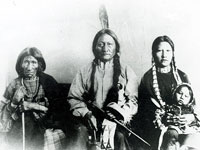Fort Buford State Historic Site [ND]
Fort Buford State Historic Site preserves remnants of a vital frontier plains military post. Fort Buford was built in 1866 near the confluence of the Missouri and Yellowstone Rivers, and became a major supply depot for military field operations. Original features still existing on the site include a stone powder magazine, the post cemetery site, and a large officers' quarters building which now houses a museum. Fort Buford, located near present-day Williston, was one of a number of military posts established to protect overland and river routes used by immigrants settling the West. While it served an essential role as the sentinel on the northern plains for 19 years, it is probably best remembered as the place where the famous Hunkpapa Sioux leader, Sitting Bull, surrendered in 1881.
The site offers a short film, tours, exhibits, and occasional recreational and educational events.
